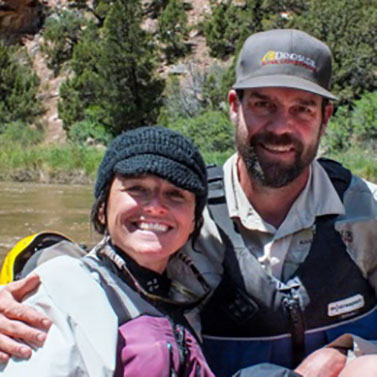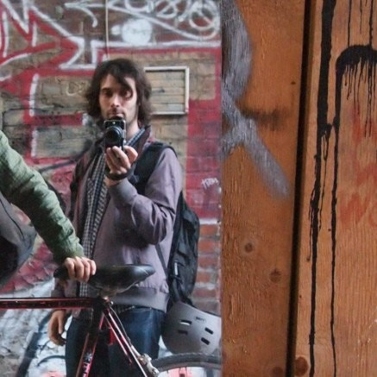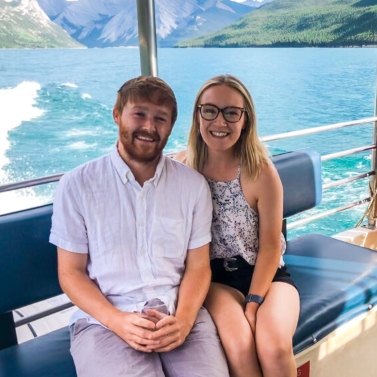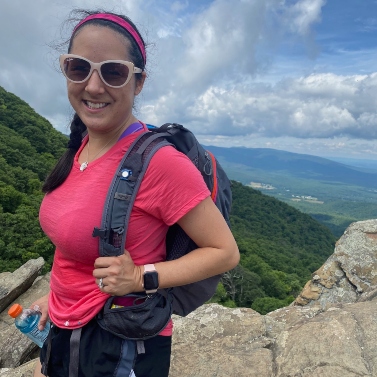What adventure spots around the world do you want to explore?
Everyone with a travel bug has a bucket list of places they want to visit someday. Some outdoor enthusiasts have shared with us the adventure spots they are itching to explore. Keep reading to see if any of these places deserve a spot on your own bucket list.

Joseph Greene
Joseph Greene is a Zoologist specializing in Ornithology and the founder and CEO of Trinidad Birding.
Hiking at the Brecon Beacons of Wales
I would love to one day go hiking in the Brecon Beacons of Wales in the U.K. It has stunning landscapes and challenging hikes. It is home to some fantastic species of birds such as the Peregrine Falcon and many Red Kites. I think it will be a fascinating place to camp for a few days, and I hear the people of Wales are as friendly as any.
Hike Through Israel National Trail
I would love to hike the 1000 km (620 mi) Israel National Trail (Shvil Yisrael). I love desert hiking and I’m Jewish, so this would be an excellent way to immerse myself in an epic Israeli-flavored adventure. It would be amazing to lead a group there, but I’d also be happy to go it alone.
Africa
Africa has always been one of the continents at the back of my mind as a place that I wanted to visit at least once. While I’ve never been to Africa, my passion for animals and seeing the natural world has always been there. There’s just something about the vast wilderness, the seemingly endless plains, and the animals that roam free that I’ve always wanted to experience for myself.
There are so many African animals – including lions, rhinos, hippos, and elephants – that I need to see for myself. From what I’ve read, there are even more exotic (and dangerous) animals in Africa. I was surprised by that. It makes sense, but it’s still hard to believe.
Lofoten Islands in Norway
At the top of my wishlist for outdoor adventure spots is the Lofoten Islands in Norway. As any photo of this region shows, the scenery alone makes for some truly spectacular sights. Lofoten is also well known for having an unlimited supply of options for hiking, kayaking, climbing, and skiing, depending on the season.
In particular, while many of the hiking and climbing trails are meant to be pretty tough given Norway’s fairly steep mountains, the views are also supposed to be breathtaking. I can’t wait to see them for myself and experience all of the adventures that this part of the world has to offer.
Larry Snider
Larry Snider, VP of Operations of Casago Vacation Rentals.
Chiang Mai Rainforest
One adventure spot that is at the top of my bucket list is the Chiang Mai rainforests in Thailand. Thailand has a lot of beautiful sights to see, but the rainforest is a great destination for outdoor enthusiasts. I’d love the opportunity to enjoy a Flight of the Gibbon adventure package, which includes rock climbing, ziplining through the rainforest canopy, and an overnight stay in a traditional village hut.
This is a crowdsourced article. Contributors’ statements do not necessarily reflect the opinion of this website, other people, businesses, or other contributors.
How do you prepare for nature-oriented activities during monsoon season?
During monsoon season, simply singing “Rain, rain, go away,” probably isn’t going to cut it when you’re going to be spending time outside. Preparation is vital to keeping yourself comfortable and healthy. Some outdoor-enthusiasts provided some tips to prepare for nature-oriented activities during monsoon season. Keep reading to learn from their experiences.
Van Rees
Dr. Van Rees is a conservation scientist, naturalist, and nature guide based in the United States. He is the founder of Gulo in Nature.
Manage the Moisture
Managing moisture is the name of the game. Your equipment, clothing, and body can all be affected by the excessive rainfall of a monsoon climate. You’ll want to have frequent changes of clothes available, specifically socks and underwear, especially if your skin isn’t accustomed to high humidity.
Make sure that you have moisture-wicking clothing so that wetness doesn’t stick to you and so you can dry once you’re indoors. Wool can keep you warmer when wet, but this isn’t a big priority in tropical climates (unless you’re moving back and forth from air-conditioned indoor environments).
Having antifungal powders and creams with active ingredients to combat athletes’ feet is a good way to be prepared for any unwanted fungal skin infections that can come from excess moisture. Keep these and other moisture-sensitive items in a designated dry bag.
I strongly recommend packing a heavy-duty rain poncho. Army-navy surplus stores tend to have excellent ones. It’s good to have a spare, or for a cheap backup option, keep a few large garbage bags folded up in a ziplock bag in your backpack. These can double as a tent fly, bag cover, or even raincoat in a pinch. Tear three holes in a garbage bag, put your arms and head through them, and, voila! Emergency rain layer. Another great emergency option is to have waterproof matches or some other firestarter available.
Plan ahead for how many days you will go without access to opportunities for drying your clothing and equipment. Will you need a place to store wet clothes? You’ll want to make sure that they get to air out for some amount of time to prevent mold and mildew growth, which can damage fabrics and make them smell. If you’re hiking or outdoors for multiple days, it can be good to have a separate bag to carry wet things or find a way to hang them outside of your backpack so they can air out a little.
Waterproofing coatings for several products are available through most outdoor outfitters. Waterproofing parts of your bag or hiking boots might be a smart idea depending on what you’re bringing with you.
Enjoy the Rain by Being Prepared
The best way to enjoy nature activities during the monsoon season is to be prepared. Here are a few tips:
- Check the weather forecast before heading out. This will help you dress appropriately and plan your activities accordingly.
- Wear comfortable, waterproof shoes. This will help you keep your feet dry and avoid slipping on wet surfaces.
- Bring along insect repellent and mosquito nets. Mosquitoes are more active during the rainy season, so it’s important to take precautions against them.
- Pack snacks and plenty of water. Since you’ll likely be spending more time outdoors, it’s important to stay hydrated and fueled up.
By following these simple tips, you can make the most of nature activities during the monsoon season. So get out there and enjoy the rain!
Adam Lee
Adam Lee from Ultraposite: Thoughts in my head trail running.
Embrace Layers
Find good waterproof gear and embrace layers. If you can ensure you are comfortable, even during heavy rains, you will enjoy yourself out there so much more.
A good thermos that allows you to keep warm drinks on hand can be nice as well. A good water filter means you don’t have to carry as much water, as there are more opportunities to refill during the wet season.
Finally, make sure you have a dry change of clothes and a snack waiting in the car. When you get back you will be very happy to have some food and warm clothing to change into while you reminisce about your fun monsoon season outing.
This is a crowdsourced article. Contributors’ statements do not necessarily reflect the opinion of this website, other people, businesses, or other contributors.
What is your preferred outdoor activity for unwinding?
The hustle and bustle of life often leaves us needing a therapeutic escape. At Dinosaur River Expeditions, we think there’s no better way to unwind than on a whitewater rafting expedition, but that’s not the only way to enjoy nature. Keep reading for additional ideas on how to unwind in the great outdoors.

Angie Berrett
Angie Berrett, Registered Nurse, and Advanced Trauma-informed Yoga Instructor is the Owner and Creator of the Angie Berrett Movement.
SUP Yoga
My preferred outdoor activity for unwinding is Stand Up Paddle Board Yoga or SUP Yoga! SUP Yoga is the best activity to unwind! Flowing through a yoga practice on a paddle board requires intense focus, otherwise, I fall. Falling into the water has helped me train my mind to be more in the present and let go of everything else in life.
SUP Yoga inspires heightened attention to my body. This allows me to notice where I may be holding stress and tension, and then release it. I am also more connected to activating my muscles, having a greater sense of embodiment.
“Savasana”, or “Final Resting Pose” done laying on a paddle board and gently rocking while listening to the sounds of nature allows my body to unwind. The gentle waves of the water are so soothing. I come out of a SUP Yoga practice more refreshed than anything else!
Scuba Diving
My favorite way to unwind from the usual daily pressures is to not only escape the office but to leave the land for the beautiful deep blue. Scuba diving is a passion of mine and it’s hard to explain the weightless feeling underwater. You can enjoy pure escapism and immerse yourself into nature. Diving is incomparable. I love to walk in the wild but diving feels so refreshing.
Fly Fishing
My favorite activity to unwind is fishing.
More specifically, I’d say fly fishing. Fly fishing takes you to some beautiful, pristine places and requires total concentration on the fly at all times (you never know when the fish will strike), so it is almost like a form of meditation. Even the casting motion is a beautiful, fluid movement when done right. It just feels good and helps relieve stress. Many good fly fishing spots don’t have good cell phone reception meaning your inner peace is less likely to be disturbed.
Hiking
My preferred outdoor activity for unwinding is hiking. Getting some fresh air, exercising, and taking in the scenery around me is rejuvenating. Hiking is full of possibilities. You never know what wildlife will be seen from the trails. And, the different seasons make each visit unique and exciting.
Overlanding
After many, many years of camping and hiking in remote areas of the world, such as Nepal or Costa Rica, I finally discovered overlanding. It happened by pure chance when I was driving around Australia, and I saw all these rooftop tents on top of vehicles. I bought one when I got back home, and since then I never looked back.
I love the idea of being able to go to beautiful national parks or remote beaches, park my car, open my tent in just a few seconds, and be able to roam around the area, just like when I go camping or hiking, but with the advantage of coming back to the campsite and sleeping like a rock in a comfy tent. It gives me the best of both worlds.
My family and friends love it, as we not only sleep well, but we have all we need on our vehicle: a small portable kitchen, a portable fridge, and gear or accessories to make sure we have a nice outdoorsy weekend on the coast of Oregon, or near the beautiful valley of Sedona. You get to drive on scenic routes, get adventurous on muddy trails, and breathe nature’s fresh air after setting up camp in less than five minutes.
Boondocking
My favorite outdoor activity to help myself unwind is going boondocking. I love nature and being immersed in it helps me to relax and unwind after a long week. When you boondock, you are also more likely to be alone, so it is very quiet and peaceful. I take a tent and other bare minimum supplies and go on hikes with my dogs.
This also allows me to explore new areas, see wildlife and be away from technology. Although I take my phone for emergencies, I do not have it with me when I am by the fire, enjoying the peace. This has helped me so much with my mental well-being and fully unwinding.
This is a crowdsourced article. Contributors’ statements do not necessarily reflect the opinion of this website, other people, businesses, or other contributors.
What should you put in your adventure bag when going out rafting?
Outdoor water activities are a fun way to enjoy summer. However, being unprepared may ruin your experience. Keep reading to find out which items to bring on your outdoor water adventure.
Pack an Extra Pair of Clothes
An extra pair of (dry) clothes will be a welcome addition to your adventure bag at the end of a day of rafting. As much as you’d like to think you won’t get wet, you’ll be soaked by the time you get down the river. Having a dry pair of clothes waiting for you will make the rest of your day so much more enjoyable than having to walk around in wet clothes for a few hours.
Comfortable and Waterproof Footwear
Outdoor activities like water rafting are great adventures that you or your friends can do anywhere around the world.
Personally, I believe that you should make sure to pack a good pair of comfortable footwear in your adventure bag if you’re going to participate in water rafting. Of course, you’ll want to make sure that your shoes are waterproof and that they have a good grip on them too. This will help you to feel most comfortable during this activity. Wearing the right pair of shoes can prevent you from obtaining a serious injury too.
The Essentials
Here are the items that should always be in your adventure bag if you’re planning an outdoor activity like rafting:
- 2x quick-dry clothes/swimwear
- River shoes
- Head protection, like a sun cap
- Sunglasses (preferably with a strap)
- Water bottles, and hydrating snack bars
- A towel for drying and a wind protector for when you’re out of the water
Tyler Callantine
Tyler Callantine has more than 30 years of river guide and white water rafting experience from all over the western United States. His favorite river trips are right in their own backyard — on Colorado’s world-famous Yampa River and Green River through the Gates of Lodore. Find him at Dinosaur River Expeditions.
Rain Gear is a Must
There are a few items that I always make sure to have with me when I go on an outdoor adventure. A good quality rain jacket and rain pants are always in my kit.
I like breathable Gore-Tex material. It keeps the moisture off and breathes, so if I am river rafting I do not get too sweaty inside the jacket and pants. Good rain gear also doubles as a splash layer on a rafting trip or a nice piece of equipment for warming up if you get chilled.
Besides rain gear I never forget a good water bottle. Bigger is better and something that is strong and durable. A water bottle that can be dropped, beat up, and still work well is important.
Extra Plastic Bag and Swiss Knife
- Avoid unnecessary items. Just bring your clothes wrapped in plastic, your action camera because it’s lighter and make sure it’s waterproof. Leave the rest behind.
- An extra plastic bag. During the rafting, expect everything to get wet. So prepare yourself and make sure to bring many plastic bags.
- A swiss knife. But make sure it’s well kept because it may prick your boat and deflate it. A swiss knife can be a lifesaver, and having that in your belongings can save all of you during your trip.
This is a crowdsourced article. Contributors are not necessarily affiliated with this website and their statements do not necessarily reflect the opinion of this website, other people, businesses, or other contributors.
What makes water rafting a good team-building activity?
Team-building activities have many benefits for companies big and small. Forging bonds, learning how to work together and spending time together can do wonders for the workplace. Read on to find out why water rafting might be the perfect team-building activity for your group.
Whitewater Rafting Involves Teamwork
The entire raft has to work together in order to navigate the rapids, safely and effectively. If one side of the raft is working against the other side of the raft, you’re going to be going in circles. Rafting is a great exercise in helping your team to learn to work together, communicate clearly and quickly, and most importantly, have fun together. Rafting is great fun, great exercise, and a great way to help your team come together and connect with each other.
Rafting Creates Motivational Memories
When teams return to their workplace, the shared water rafting experience becomes a crucial resource for long-time bonding. The highest level of team bonding ensues following a formative activity, which is both meaningful and high-pressure. Rafting can serve the purpose of a formative activity for your team.
The enchantment and competition will create a robust bonding experience, which your team will remember for countless years. Take a break and reminisce [about] your rafting experience whenever your team faces the next roadblock. Such collaborative recollection will help bring back happy memories and get them laughing.

Cindy Corpis
Cindy Corpis, CEO of SearchPeopleFree.
Rafting Engenders a Positive Culture
If you’re the coach of a youth sports team or a business owner, you must understand the value of a positive culture. When employees look forward to their time together and reminisce about what they have been through, they will feel more valued and [are] more likely to work hard towards business goals.
The memories and fun from the rafting activity are likely to carry over into their daily lives. Employees can talk for months about their trip together, which they enjoyed from the core of their hearts. Also, apart from team building, the previous rafting memories will allow them to plan another trip next summer.
A Fun, Challenging, and Rewarding Activity
White water rafting is a great team-building activity because it is fun, challenging, and rewarding. It is really important for a team-building activity to be fun to ensure that all members of the team are giving it their all and are enjoying themselves. However, the fact that it can be quite challenging provides the perfect opportunity for teamwork.
At the end of the experience, the team members can come away from the experience feeling rewarded and like they have been able to accomplish something. This makes them more likely to take the lessons that they have learned from the experience with them into the future. White water rafting can also help to bring team members closer together while building up a solid foundation of trust.
Teamwork To Succeed
Water rafting makes for an excellent team-building activity because it is a challenging, fun, and exciting experience that requires participants to work together to succeed. By working together as a team, participants can learn more about each other’s strengths and weaknesses, communication styles, and problem-solving abilities. By conquering the challenges of water rafting together, participants can build trust and camaraderie that will help them to work more effectively as a team in the future.
Boosts Confidence And Communication
It doesn’t matter whether your team is a build-up of adrenaline-coated sunflowers or nervous roses; water rafting is one of the best activities for everyone. It is best suited for groups of all sizes! If you are a small team, you can stuff together in one, and if you’re in bigger groups, you can create a fleet of rafts. This trilling team-building activity boosts confidence and communication. Therefore, you shouldn’t miss out on that!
Three Reasons Rafting is a Good Team-Building Activity
It compels you to not slack off:
You’ll be with at least six people while white water rafting. Each one of you will have to pull your weight to complete this task. And even if just one of you slacks off, everyone else will feel it. That compels you to do your best.
You’ll see everyone’s potential (or lack thereof) as a leader:
White water rafting requires teamwork, and at some point, one of you will have to step up and take the lead. That, right there, puts every single one of you to the test to see who has leadership qualities.
There is a strong sense of accomplishment after:
Nothing brings people closer together than having that feeling of accomplishing a tough challenge. From that kind of strenuous activity, people get to forge strong bonds with one another.
This is a crowdsourced article. Contributors are not necessarily affiliated with this website and their statements do not necessarily reflect the opinion of this website, other people, businesses, or other contributors.
What outdoor activity do you want to try but are somewhat afraid to pursue?
This world is full of adventures to be had, and every day is a chance for a new experience. Here at Dinosaur River Expeditions, we have a passion for white water rafting. But, we realize that some people may be afraid to try this type of adventure. Find out what other activities some of our readers dream about but are hesitant to pursue.
Underwater Photography
I am an amateur photographer who loves taking pictures of nature while going on hikes. I follow numerous social media accounts, and some of the coolest photos I’ve ever seen have been shot in an underwater setting. These include photos of colorful tropical coral reefs, spooky shipwrecks, and aquatic animals.
The problem is that I am slightly nervous about being in the ocean without solid land nearby because I know that there could be dangerous creatures lurking beneath the waves. I’ve tried snorkeling in the past, and I did not enjoy it because I was afraid that I was about to get stung by a jellyfish, or worse, that a bull shark was closely following me.
I know that there are dry-box style underwater cameras that can be used to take underwater photos without the need to go fully in the water. But for this challenge, I would need to take scuba diving lessons to get the desired pictures. Luckily, I’m not afraid to learn how to go scuba diving – it sounds quite fun to me!
Even though I don’t live near the ocean, I can still take diving lessons at a specialized swimming pool and learn how to use the equipment needed for underwater photography.
I know that my fear of ocean animals that sting and bite is irrational, and learning more about these creatures and the low risk that they pose may help me control my fear and perhaps overcome it.
I’ve been reading a lot of articles about these underwater photography adventures, and I hope that someday I can take a photo of a colorful reef or a manta ray swimming through the water.
Paragliding
I have always wanted to experience paragliding. It seems like an activity full of thrill and one that I have been looking forward to for as long as I can remember.
Sadly, my extreme fear of flying has prevented me from pursuing this activity. However, I plan on overcoming this fear, through this peerless aerial sport, on my next trip to Australia.
Scuba-Diving
An outdoor activity I would love to try but am somewhat afraid to pursue, is scuba-diving.
The thought of being so far below the surface of the water, surrounded by sea life on their terms, is an equally liberating and nerve-wracking thought.
On the one hand, being so close to animals we rarely get to see outside of nature documentaries would be an incredible, once-in-a-lifetime experience. It would be fascinating to watch the fish dip and dive between the coral while being so close to them.
Yet there is still a little part of me that thinks, despite how many people regularly dive all over the world, what if something goes wrong while I’m down there? You hear horror stories of people surfacing too quickly or panicking when they are 20m below the surface.
For now, the prospect of me scuba-diving very shortly is slim, but I won’t rule it out entirely.
Skiing
One outdoor activity that I want to try is skiing, but I have been afraid to pursue it. A few reasons, one being I’m in my mid 30’s now, so I’m afraid it will be too hard to learn at this age. I’m afraid of falling and hurting myself, it can be too cold, and I’m terrified of getting on a chairlift.
Skateboarding
In recent years, influenced by friends and online influencers, I’ve started getting fascinated by skateboarding. I truly want to give skateboarding a go, but I am somewhat afraid to pursue it. This is mainly due to the physical risks and, consequently, [the work related consequences] that come with skateboarding.
From what I’ve read and seen, skateboarding is quite physically demanding – falling off and hitting the pavement is part and parcel of the activity. For a working adult at the age of 30 who’s just started noticing lower back issues and joint tightness, that’s quite scary!
Though I find the sport cool, I am unsure if injuring myself is worth it. I have to consider the risk of physical injury that may also cause me not to be able to work at full capacity. Being a business owner, I have to weigh those risks, as they may affect my business operations too.
Perhaps that’s why most skateboarders are young children and teens who are more resilient physically and lifestyle-wise.
Rock Climbing
One outdoor activity I’ve been very interested in for a couple of months now has been rock climbing. I love the outdoors, and hiking is something that I often do to de-stress. On those hikes, I usually see people rock climbing, and it has always fascinated and interested me.
However, I have a slight fear of heights, and I worry that the activity would trigger that fear and pull away from my enjoyment of it. This is the main reason why I’m still hesitant to try it, even though it seems like a good way to train myself.
I am doing my best to work on that fear, though, as I plan to take my approach to rock climbing slowly and perhaps start in indoor gyms before moving on to the outdoors.
Cycling
I’d say cycling is a nice outdoor activity I’d like to get into. More specifically, cycling to work instead of public transport. It’d be a nice, refreshing change of pace from the usual routine.
I’m slightly afraid, however, [because of] the number of mishaps I’ve seen occur on the road involving cyclists. Their safety on the road seems to rely heavily on factors around them.
Is there a cycling lane on the road? Are drivers paying as much attention to cyclists as they are to other vehicles? The answers, at least where I commute, don’t seem very encouraging. So you might see why I’m a bit hesitant.
Skydiving
It’s a bit of a cliché bucket list outdoor activity, but I’ve always wanted to go skydiving. I feel like it’s the kind of thing you should do once in your life, and I’ve been slowly hyping myself up for the idea of it.
However, I am terrified. I’m worried that once I’m up there, and it comes to jumping out of the plane, I will completely freeze up and be unable to do so. And I’ve also seen some horror videos, including one in which a woman’s harness became stuck on the plane’s wheel as she jumped, and although the trainer managed to get her out of that situation, it could have resulted in her death.
So yeah, it’s big on my bucket list, but there are still some big worries I need to overcome to take that leap of faith.
Wilderness Camping
The outdoor activity that I want to try but am somewhat afraid to pursue is a wilderness family camping trip.
As in, the ones in which you set destination goals, pack the essentials, and then go on a little weekend adventure, aiming to get there while figuring out the route as you go. Survival-style camping. I’d love to do it with my family, as I think it would be an amazing experience.
However, I’m worried that if anything happens during the trip, I won’t have the right skills or knowledge to provide a solution. I’m not exactly an outdoors person, so I really wouldn’t know what to do in an emergency.
Maybe I just need to do some research, and practice a few skills before I feel confident enough to plan the actual activity.
Surfing
The outdoor activity I have wanted to try for years is surfing. I am afraid to try it out because I am not the best swimmer. When I was younger, I got stuck in a crowded wave pool and spent a lot of time underwater. The hopeless feeling I felt at that moment has stuck with me.
While I love the ocean and even wanted to pursue Marine Science at one point, my below-average swimming skills are holding me back.
Perhaps, I could try doing swim lessons, but surfing involves more than just being able to swim. It involves being aware of the currents and rock formations underwater and having balance, which I am also lacking (in more ways than one).
Cliff Diving
I have always wanted to try cliff diving, but my fear of heights always gets the best of me. The thrill and scenery appeal to me, and I’ve tried multiple times to schedule a trip. Somehow, I always manage to make an excuse not to push through.
As of now, my excuse is the pandemic. I hope to overcome my fear, and I hope to do it within the next five years.
This is a crowdsourced article. Contributors are not necessarily affiliated with this website and their statements do not necessarily reflect the opinion of this website, other people, businesses, or other contributors.
Would you go water rafting on a first date?
First dates are stressful. Picking the right restaurant or activity can start the nerves even before the big night. Whether you’re looking for a fresh idea or love the outdoors, our readers recommend river rafting for your first date for several reasons. Keep reading to find out why.
Rafting Minimizes Awkward First Dates
Going on a first date is an exciting time. Full of nerves, bliss, and sometimes anxiety. You want it to go well, and you want to make a great impression with minimal awkwardness. So what’s a perfect first date activity that can tick all the boxes? Water rafting!
- You get to spend time adventuring together as your endorphins get going.
- It’s a fun way to connect, having to work together navigating the waves.
- It’s an exhilarating experience guaranteed you both won’t forget.
- You get a chance to show off how strong and brave you are because rowing through rapids isn’t for the weak-hearted.
- Most likely, there will be natural, romantic scenery.
- It breaks away from the common date ideas that can get old and boring.
- You leave a great impression of a fun, adventurous person who planned a unique experience.
It’s an Unforgettable Date
The first ideal date should be something adventurous, and it all comes down to the memory you build and the person you’re with. Water rafting is a thrilling date idea for you and your companion. Instead of having a typical night [out], spice it up with adventure. One of the reasons it is ideal for a first date is its romantic scenery. Water rafting is also a great way to increase interaction because there is always something to talk about, and it is a great way to spend quality time.
It’s a Perfect Outdoor Date
For those who love adventure and outdoor activities, water rafting is one of the best first dates out there. The adrenaline that comes from the exciting rapids, along with the downtime from the calmer stretches, makes for a perfect first date combination. As they say, nothing bonds people together like exciting experiences!
It’s A Great Way To Break The Ice
Water rafting is a great first-date idea! It’s adventurous, fun, and provides the chance to get to know your date in a new and exciting setting. It also gives you a perfect opportunity for some laughs and fun conversation to get to know your date better in a relaxed setting. Plus, there’s nothing like spending time outdoors enjoying nature to help break the ice. And, if things are going well, you can always take a swim afterward.
If you’re looking for something active to do on your date, water rafting is it! Not only will you have a blast, but you’ll also stay physically active. It’s the perfect way to spend some time together and get to know each other better.
It’s an Adventure
Rafting is a good first date activity because it is adventurous. It is a good way to connect, and you get out of your comfort zone. Plus, it could be a relaxing day under the stars with a fire at night.
Rafting Tests Compatibility
In my opinion, water rafting on a first date is a good idea because it can:
Test your patience with each other. You have to work as a team during water rafting. If on the first date you can no longer work as one, then it can be a red flag. [It] checks your compatibility. Do you both enjoy the activity?
How can you ensure the safety of your kids when taking them on a nature-related outdoor activity?
Here at Dinosaur River Expeditions, we believe that spending quality time with your kids in the great outdoors is one of the best things you can do. Since there is nothing more important than their safety, we’ve asked our outdoor-loving readers to share some tips to ensure your children’s safety while adventuring outdoors.

Mike Nicosia
Mike Nicosia is the founder of Conquerwild.com, a blog site that focuses on creating informative content for campers and hikers around the globe.
Follow The 5-Second Rule, Dress Appropriately, and Stay Hydrated
Outdoor activities can be a fun way to bring the whole family together, but there’s also a risk of danger. To ensure the safety of your children, you need to obey the 5-second rule. This means that you don’t allow a child under eight years old to escape your line of sight for more than five seconds. When you’re around water, this becomes the 2-second rule.
You also need to be aware of the weather for the day. Dress your children appropriately based on the conditions you’re expecting. If the temperature is expected to drop below 32 degrees Fahrenheit or zero degrees Celsius, you should stay indoors.
Regardless of the temperature, make sure your children are well hydrated before you embark on your adventure. Bring lots of water with you as well.
Discuss Rules, Provide Adequate Shoes, and Bring a First Aid Kit
I take my two young daughters hiking and camping in remote wilderness areas. There are many potential dangers, like snakes, cliffs, and sharp rocks, [with] absolutely no one nearby to call for help.
The key to making sure they stay safe in these environments is making sure they understand the “rules.” For example, they are never allowed to leave the trail or hike out of sight of me. They also know never to pick up large rocks because there may be snakes hiding underneath.
There are also many measures I take to prevent accidents, like making sure my kids have adequate footwear for the terrain. I also always have a first aid kit with us, even on “easy” hikes.
But, by far, the best thing I did to keep my kids safe outdoors was take a first aid course. It gives me peace of mind knowing that I could treat a snake bite, knife wound, or even a fractured bone in the field.
Explain and Teach
The best way to ensure that the kids are safe during a nature-related activity is to prepare them for the trip. It’s best to give them a mental picture of where they will be, what they can expect, and the things that they are allowed to do there.
You can also explain to them the possible dangers that can happen but make it an interesting learning activity and try not to scare them off. An example is to not touch all mushrooms, as they can irritate your skin.
Teach them that it’s not fun to get lost in the forest as there is no electricity at night. Teach them that bears are cute, but we should be careful of them. Help them understand that being safe does not need to spoil the fun and excitement.
Prepare and Enjoy
Don’t let fear of your child getting hurt prevent you from helping them explore nature. Kids are born to want to explore, and learning about nature is so important for them to thrive and grow. There are plenty of ways to make sure you’re prepared when getting outdoors with your kids!
Here are a few of my top tips:
1. Make sure to pack a first aid kit in your backpack. If your child has known allergies and requires an EpiPen or similar treatment, be sure to have that on hand. Sunscreen, bug spray, and water to help clean any cuts that may occur are great essentials as well.
2. Dress weather appropriate – Layers are great for weather changes that may occur while out for the day. Long sleeves, pants, and closed-toed shoes with socks are preferable.
3. With kids, it’s always great to have drinking water and snacks with you to help prevent cranky moods after a lot of fresh air. Good moods mean kids are more likely to pay attention to directions and safety precautions.
4. Encourage your children to observe everything with their eyes but ask before touching plants in case of poison ivy/oak. Knowing what poison ivy and oak look like ahead of your outdoor adventure is always a good idea.
Keeping these tips in mind and being prepared can help you have fun along with your kiddos and enjoy being in the moment with them!
Discuss Safety Rules
Talk about the activity with them ahead of time. Explain how to do it, how to do it safely, and what not to do. They need to know what actions might result in injury and what they should be doing to prevent that.
Then, before you start doing the activity, quiz them on the things you just told [them]. It will also make it easier for you to spot them acting in a way that might get them hurt, which will allow you to quickly call them out or make them stop before anything bad happens.
Provide Constant Communication
The best way to ensure the safety of your children when you have a nature-related outdoor activity with them is to keep constant communication. Make sure you all have a walkie-talkie or some other form of radio. Make sure you and your children have your cell phones for secondary communication.
Keep all children in eyesight, do not let them wander off out of your sight. Set up special code words for children to yell in case of things like animals or other dangerous situations, so it acts as a signal to everyone else on the walkie-talkie.
Teach and Prepare for Animal Encounters
When bringing kids outdoors in a nature-related activity, it is best to clothe them appropriately with gear that protects their hands, arms, legs, and feet. This is because these parts of the body are most vulnerable to possible attacks by snakes or other venomous animals that you might encounter.
It’s also a good idea to educate them on basic animal encounter etiquette, like what to do when they spot or come face-to-face with certain wildlife.
Another thing that might help is to give each of them an alarm whistle that they can use in case they get lost or hurt.
When hiking or camping for more than one night, it’s not a bad idea to inform the local authorities about your itinerary so they can respond promptly in case of any untoward incidents.
Keep Your Children Within Eyesight At All Times
Make sure that you have your eyes on [your children] at all times. In the perfect scenario, there would be one adult per child so that each child can be equally looked out for, but that’s not always going to be the case. If you are outnumbered by kids, make sure that the activity you are doing allows them to be within your line of sight at all times.
They should also remain close to you so that you can easily get to them in case of an emergency. If you need to go to the bathroom or briefly leave for even just a couple of minutes, make sure to bring them with you.
Plan and Prepare
One thing to ensure kids’ safety during a nature-related outdoor activity is to plan. Before embarking on the trip, make sure to check the weather if there are chances of rain, strong winds, or if it is sunny.
Next, prepare the gear. Make sure to have all items and outdoor gear ready such as walking sticks, hats, sunblock, water bottle, trail food, raincoat, radio, GPS, and map, among others. Also, it would be good to have a first aid kit ready in case accidents happen.
This is a crowdsourced article. Contributors are not necessarily affiliated with this website and their statements do not necessarily reflect the opinion of this website, other people, businesses, or other contributors.
What factors should you consider when choosing your next rafting expedition?
White water rafting is an exciting and memorable experience. Many people get hooked after their first expedition. If you are one of those people, you may be wondering what factors you need to consider as you choose your next rafting adventure. Keep reading to find out how some rafting enthusiasts answered this question.

Mark Whitman
Mark Whitman, Founder of Contentellect, a content writing service, and an avid adventurer and travel blogger.
Grade Level and Added Adventures
Definitely [consider] how adrenaline-packed the expedition is. I look for river rafting on Grade III and IV rapids, along with whatever high octane adventures I can do alongside, such as zip-lining, mountain biking, and climbing.
Expedition Difficulty
Personally, when I’m choosing my next rafting trip, I factor in how much difficulty I’m looking for. Some expeditions are more relaxed, which are great for times when I’m not looking for anything dramatic. They provide gorgeous views and a great experience. However, there are other times when I want a real challenge, which is when I’ll opt for a more advanced expedition with steeper chutes and complex routes.
Difficulty, Location, and Scenery
I like to switch it up, so I’ll consider the difficulty of the rafting as well as the views of the location. If I recently did some intense white water rafting, I’ll likely choose a calmer river for my next trip. I’ll also try to pick new places to try or at least places with different scenery than my most recent trips. This gives me an excuse to travel more and visit new places.
Weather Conditions
When deciding to go for a rafting excursion, the weather plays a crucial role. While rafting, I usually keep an eye on the weather because it can quickly change from sunny to cloudy. It’s mostly about the addition of clothes that we can pack ahead of time, rather than the weather conditions suitable for rafting. Keeping some warm clothing on hand is always a good choice.
This is a crowdsourced article. Contributors are not necessarily affiliated with this website and their statements do not necessarily reflect the opinion of this website, other people, businesses, or other contributors.
How To Get Started With Whitewater River Rafting
Few things are as thrilling as whitewater rafting—the anticipation of the next big wave, that exhilarating drop in your stomach, the river’s spray cooling your body. If you want in but don’t know quite how to get started, read on for tips from rafting enthusiasts to help you ease into the sport.
Seek Out Reputable Companies
Outdoor activities can seem a bit daunting if you’re not familiar with them, but water rafting is a fun way to get started. The best way to get started is to find a reputable company that offers beginner-level rafting tours.
The guides will give you all the necessary instructions and safety gear, so you don’t have to worry about anything. They’ll also provide transportation to and from the river, so all you have to do is show up and have fun. Just make sure you dress appropriately for the weather and water conditions. The guide will also go over this with you, so you are prepared to hit the water.
Learning The Basics Of Rafting
The single most important thing you can do if you want to start whitewater rafting and have no experience is to find someone else to teach you. If you’ve got a friend who’s willing to take you down in their raft and show you the ropes, that’s great (though you’ll likely still want to take a River Rescue class at some point before you go it alone). Otherwise, I highly recommend taking a guiding class from any of the number of rafting companies that offer them across the country.
The next suggestion I would make is when you’re ready to buy your first raft, buy a high-quality used one. In the beginning, you don’t know what size or type of raft you’re going to prefer. You’re also likely to hit a lot of rocks, leave your boat in the sun too long without letting enough air out, or make any number of rookie mistakes that will damage your raft. Might as well beat up a cheaper used one, and then spend more money once you know what you want and how to take care of it.

Tyler Callantine
Tyler Callantine has more than 30 years of river guide and white water rafting experience from all over the western United States. His favorite river trips are right in their own backyard — on Colorado’s world-famous Yampa River and Green River through the Gates of Lodore. Find him at Dinosaur River Expeditions.
Research and Prepare Well for Your Adventure
If you have never been white water rafting, a thorough internet search is a good place to start. Look for reputable companies with a variety of options from beginner-friendly one-day rafting trips to multi-day rafting trips such as the Green River Gates of Lodore or Yampa River through Dinosaur National Monument – both good introductory trips for first-timers with exciting whitewater.
A local family-owned company is another good bet. They have first-hand knowledge of the area, are in touch with the entire guide staff, and quite often, a manager or owner will be on your trip. Talk with friends, family members, coworkers. Find out what type of experiences they have had with guided river trips. They may direct you to a company that they had a fabulous experience with.
Definitely ask questions of the outfitter, read the pre-trip literature they provide and follow their suggested pack list. You do not want to be out on the river for a day or four days without gear that will make your trip successful and more comfortable.
Another suggestion is to research what is available where you think you may want to go rafting. Find out what other activities are available and extend your vacation to see and do more than just the rafting trip.
Research Whitewater Rafting Locations
Begin by researching whitewater rafting locations near you. For first-time rafters, this is something that you will want to do with an experienced guide at a legitimate location. Most websites will give a synopsis about what is required from you and what they will provide. They will typically provide all or most of the necessary gear. Make sure to read over safety information posted on their website as well. If you still have questions or concerns, call them! They will be happy to ease your anxieties and answer any questions you have.
This is a crowdsourced article. Contributors are not necessarily affiliated with this website and their statements do not necessarily reflect the opinion of this website, other people, businesses, or other contributors.
















































